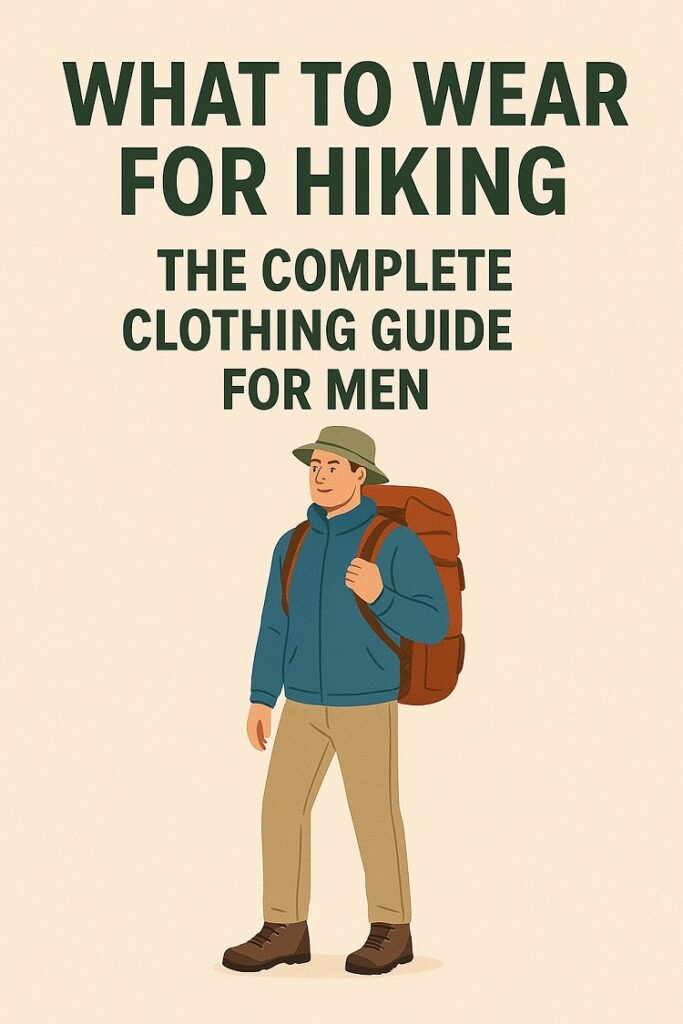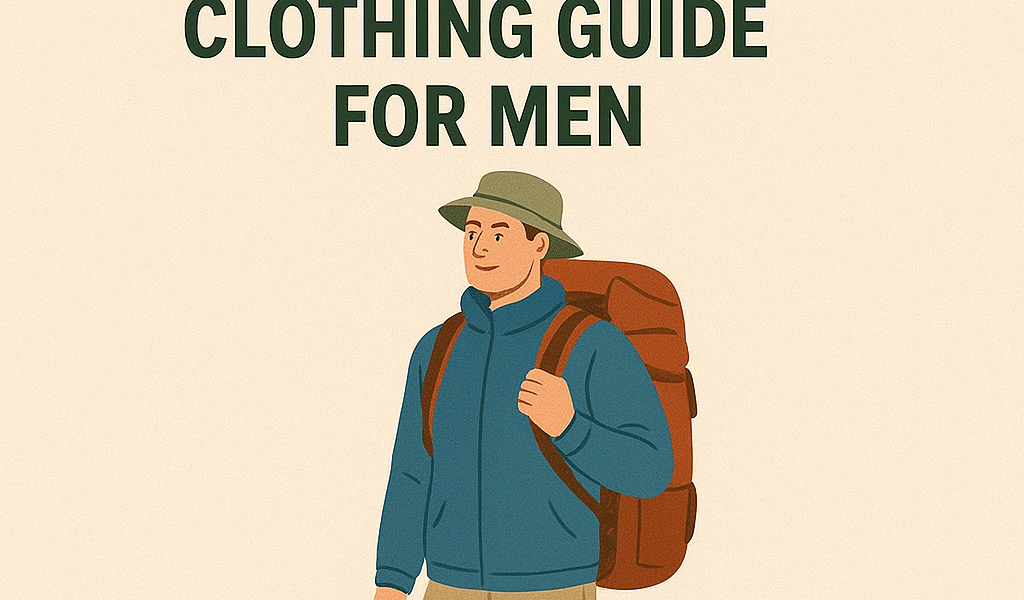What to Wear for Hiking: The Complete Clothing Guide for Men
August 28, 2025
Whether you’re planning a casual nature walk or a multi-day mountain trek, your hiking outfit plays a huge role in comfort, performance, and safety. Hiking isn’t about fashion, it’s about function. The right gear can help regulate body temperature, protect you from the elements, and prevent injuries, chafing, or blisters.
In this detailed guide, we’ll break down what men should wear for hiking from head to toe across all types of trails and seasons. Whether you’re a beginner or seasoned outdoorsman, this clothing checklist will ensure you’re ready for the trail.
Why Hiking Clothing Matters
Outdoor conditions can change quickly. You might start your hike in sunshine and end it in rain. Elevation, wind, temperature swings, and trail difficulty all demand versatile, layered, and functional clothing. Unlike everyday clothes, hiking attire is designed to:
- Wick moisture and dry quickly
- Allow freedom of movement
- Insulate without bulk
- Resist wind and water
- Prevent chafing and blisters
The goal is to stay dry, warm (or cool), and protected all while allowing your body to move freely.
The Layering System for Men
The key to hiking comfort is dressing in layers. This system lets you add or remove clothing depending on weather, effort, and elevation.
1. Base Layer (Next-to-Skin)
Purpose: Wick sweat away and keep skin dry.
Material: Merino wool or synthetic fabrics
Avoid: Cotton, it absorbs moisture and causes chills.
Best picks for men:
- Short or long sleeve moisture-wicking T-shirts
- Thermal tops for cold hikes
- Compression base layers in colder temperatures
Brands to consider: Icebreaker, Smartwool, Patagonia, Decathlon
2. Mid Layer (Insulation)
Purpose: Trap body heat while remaining breathable.
Material: Fleece, wool, or lightweight down/synthetic insulation
What to wear:
- Fleece hoodie or pullover
- Insulated vest or packable puffer jacket
- Lightweight down jacket (for colder or high-altitude hikes)
Tip: A zip-up mid-layer gives flexibility to vent as needed.
3. Outer Layer (Shell)
Purpose: Protect from wind, rain, and snow.
Material: Waterproof and breathable (e.g., Gore-Tex)
Essential pieces:
- Waterproof rain jacket with hood
- Windbreaker for dry but breezy hikes
- Softshell jackets for mobility with light water resistance
Features to look for: Adjustable hoods, pit zips, sealed seams
Pants VS Shorts for Men
Your choice depends on trail conditions, weather, and personal comfort.
Hiking Pants
- Lightweight, quick-drying, and stretchy
- Built-in UPF protection (for sun safety)
- Some come with ventilation zips or roll-up features
Convertible pants (zip-off to shorts) are great for unpredictable weather.
Recommended brands: Columbia, The North Face, REI, Fjällräven
Hiking Shorts
- Ideal for hot, dry conditions
- Choose those with water resistance and secure pockets
- Avoid cotton cargo shorts
Tip: For thick brush or buggy areas, pants offer better protection.
Underwear Matters Too
Comfort starts from the base. Invest in moisture-wicking, seamless underwear.
Features to look for:
- Breathable material (merino or synthetic)
- Anti-chafe seams
- Supportive fit for long hikes
Popular choices: SAXX, ExOfficio, Uniqlo AIRism
Footwear: Your Most Important Hiking Gear
Blisters or sore feet can end a hike early. Choose hiking shoes or boots that match the trail.
Socks
- Material: Merino wool or synthetic blends
- Thickness: Light to midweight depending on terrain
- Avoid cotton—it holds moisture and causes blisters
Pro tip: Pack an extra pair of socks in your bag.
Hiking Footwear
Trail Runners: Lightweight, breathable, good for fast hikes on smooth trails
Hiking Shoes: Low-cut, supportive, and durable
Hiking Boots: High-cut ankle
Hiking Boots:
High-cut ankle support, great for rugged or uneven trails, or when carrying a heavy pack. Look for waterproof models with grippy outsoles (like Vibram) and proper toe protection.
Popular Brands: Salomon, Merrell, Keen, Lowa, Columbia
Pro Tip: Break in your hiking boots before heading on long hikes to avoid blisters.
Accessories Every Man Should Carry
1. Hat or Cap
Summer: A wide-brim or baseball cap for sun protection
Winter: A thermal beanie or fleece hat to retain heat
2. Sunglasses
UV-protected lenses to shield eyes from the sun and glare
3. Buff or Neck Gaiter
Great for wind protection, sun coverage, or cold-weather layering
4. Gloves (in colder weather)
Lightweight liners for cool days and Waterproof, insulated gloves for winter hikes
5. Gaiters (Optional)
Prevent debris, snow, or mud from getting into your boots
Seasonal Tips for Men
Summer Hikes
- Go light and breathable: moisture-wicking T-shirt, hiking shorts, mesh shoes
- Use UPF-rated clothing and apply sunscreen
- Don’t forget hydration packs or bottles
Winter Hikes
- Use all three layers (base, mid, and outer)
- Wear insulated, waterproof boots and warm socks
- Carry hand warmers and emergency shelter in cold areas
Rainy Conditions
- Always carry a packable waterproof jacket
- Waterproof pants and boots can save you from miserable hikes
Mistakes to Avoid
- Wearing Cotton: It traps moisture and takes forever to dry
- Overdressing: You’ll sweat excessively and cool down too quickly
- Ignoring Footwear Fit: Poor-fitting shoes = blisters and injury
- Forgetting Layers: Weather can change fast, especially in the mountains
- Skipping Sun Protection: Even cloudy days can cause sunburn at elevation
When it comes to hiking, your clothing choices directly affect your comfort, endurance, and safety. Invest in quality moisture-wicking layers, durable pants or shorts, reliable footwear, and a versatile outer shell. Build your outfit around the layering principle so you’re ready for sun, wind, rain—or all three in a single day.
Whether you’re hiking your local trail or planning an overnight trek, wearing the right gear will keep you focused on the views—not on your soggy socks or chafed thighs.
Dress smart. Hike strong. And always stay prepared.
